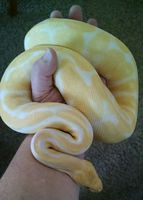FUN FACTS ABOUT REPTILES AND AMPHIBIANS
- There are 8,240 species of reptiles in the world, inhabiting every continent except Antarctica.
- Hundreds of millions of years ago, amphibians became the first vertebrates to live on land.
- Reptiles and amphibians are cold-blooded, or "ectothermic," animals, which means that they depend on external sources, such as the sun, to maintain their body temperatures. Since they don't burn energy to heat internal "furnaces," reptiles eat 30 to 50 times less food than do birds and mammals (warm-blooded animals) of similar sizes.
- Some turtles and tortoises, including the Eastern box turtle, can live for more than a century.
- Only a few hundred of the world's 3,000 snakes are venomous. In the United States, only rattlesnakes, copperheads, cottonmouths, and coral snakes are poisonous. More Americans die each year from bee and wasp stings than from snake bites.
- One way to tell a frog and a toad apart: frogs have smooth, clammy skin, while toads have more dry, bumpy skin. Both frogs and toads lay their eggs in water, but toads spend more of their time on land than do frogs.
- Averaging ten to 12 feet in length, the king cobra is the largest venomous snake in the world. It is also the only known snake that builds a nest for egg incubation.
- Frogs can breathe not only with their lungs, but also through their skin. A frog's skin is thin and contains many mucous glands that keep it moist. Oxygen can be absorbed through this thin, damp skin.
- Depending upon the size of the meal, anacondas can go several months between meals.
- More than 75 percent of all toad and frog species in the world live in tropical rainforests.
- The emerald tree boa can strike a bird or small mammal in complete darkness. The pits along the lips of most boas and pythons, and the nostril-like cavities of pit vipers, are infrared heat receptors. Snakes use these pits to sense the location of anything that differs in temperature from its surroundings by as little as 0.4 degrees Fahrenheit.






